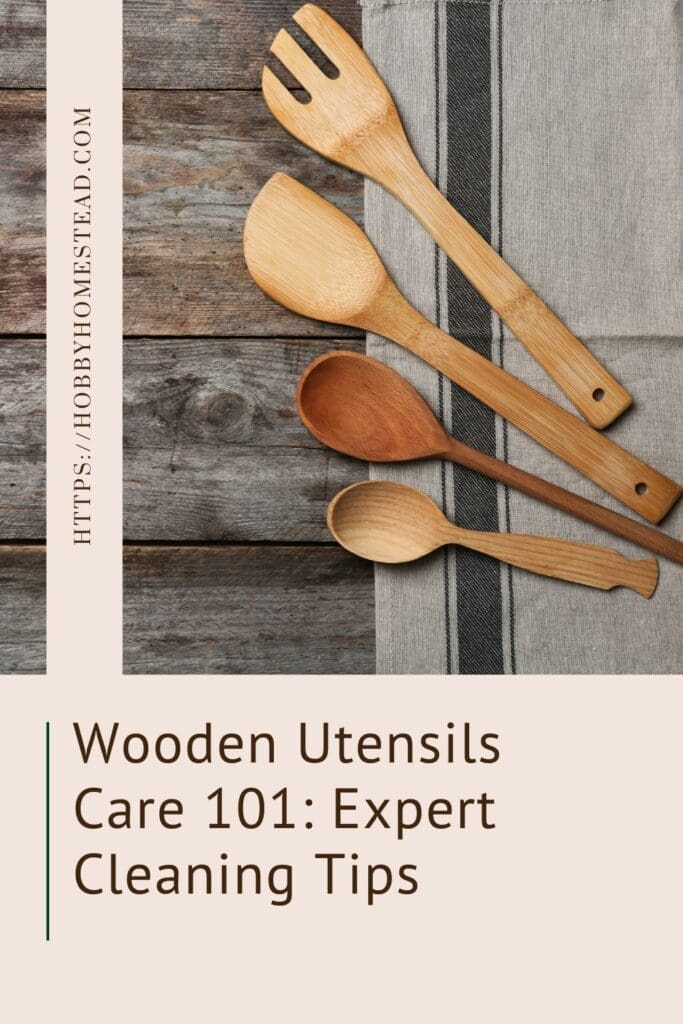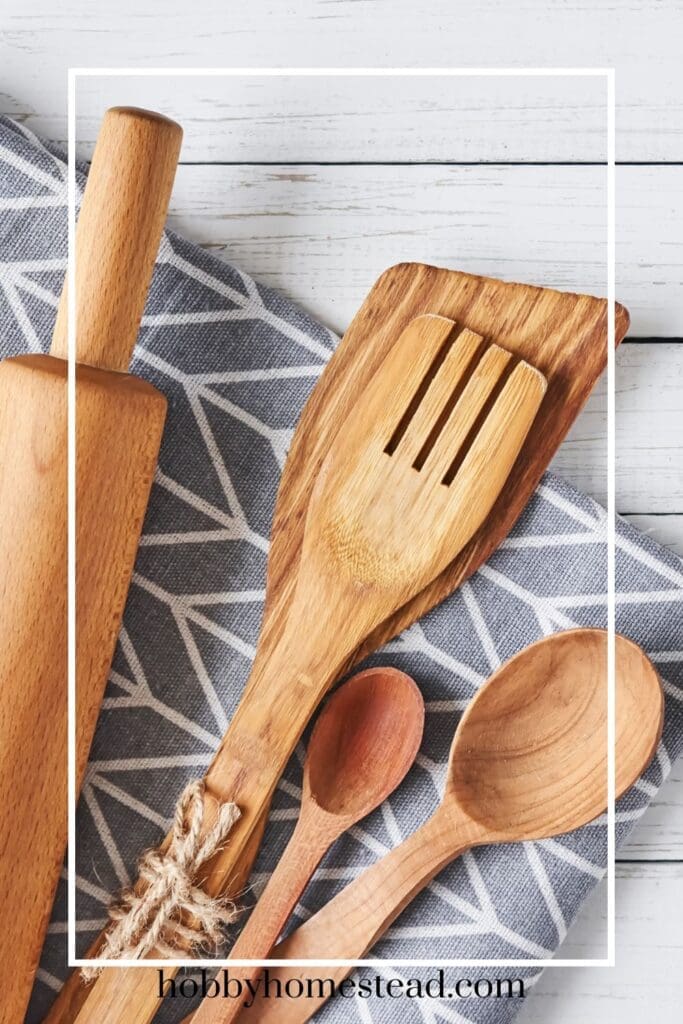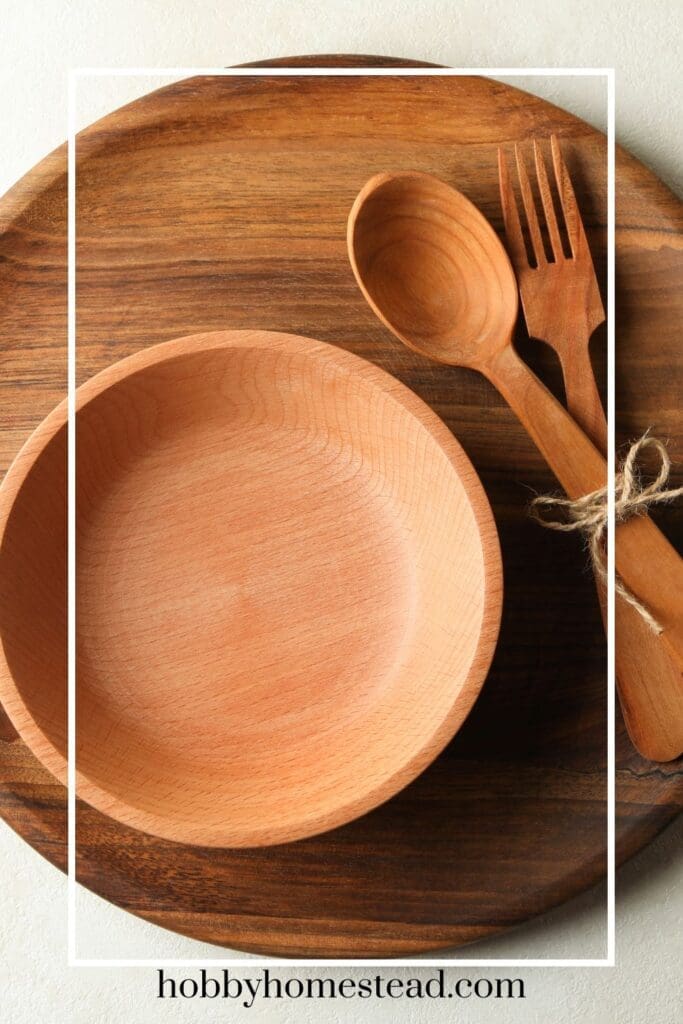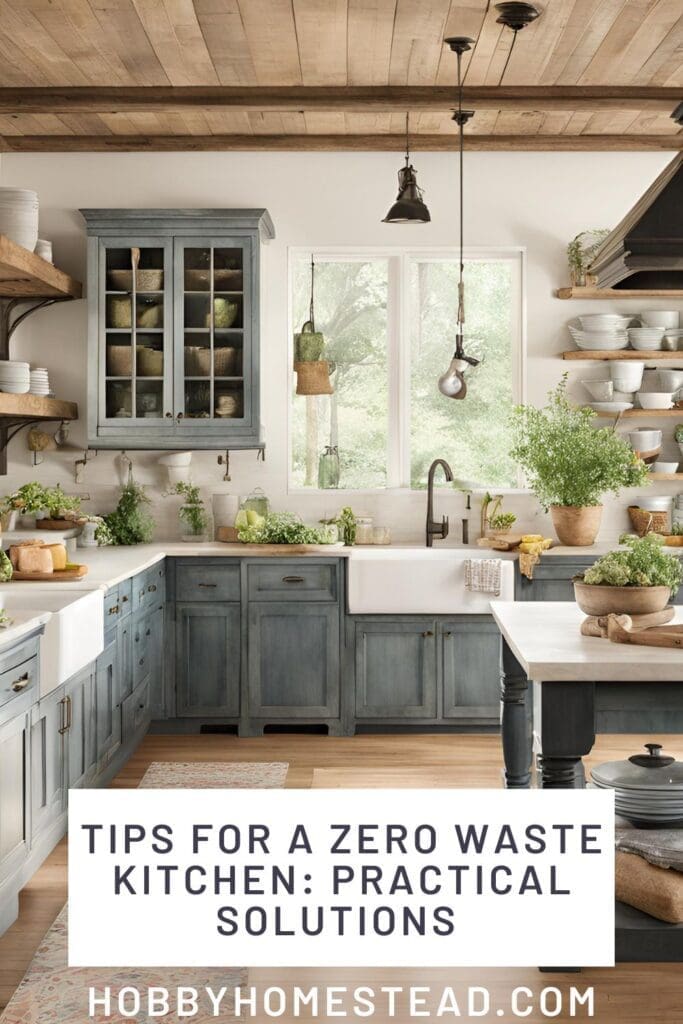Here are our Expert Cleaning Tips for Wooden Utensils Care. There’s just something special about using wooden utensils. They’re strong, long-lasting, and made from natural materials that feel great in your hands.
But to enjoy your favorite wood utensils for years of great use, you need to give them proper care.
If you’re a wooden spoon lover like me, you know. I have one spoon that I use all the time when cooking. It seems to be my go-to and I have had it for quite a few decades.
How had this lasted so long? With tender loving care. Here’s the best way to clean and care for wooden spoons, wooden cooking utensils, wooden cutting boards, and other wooden kitchenware.

🧼 How to Clean Wooden Kitchen Utensils the Right Way
The most important thing is to never soak wooden utensils in much water. Wood is a living organism in a way. It breathes, absorbs moisture, and can warp or crack if not treated correctly.
- Hand wash your wooden utensils using warm water or hot soapy water and a small amount of mild dish soap.
- Use the scratchy side of your sponge or even a little chunk of Scotch-Brite to gently scrub off food particles. Scrub in the direction of the grain to avoid rough patches.
- Rinse with hot water and immediately dry with a clean dish towel or clean cloth. Letting them air dry in extreme temperatures or direct sunlight can cause cracks.
- For stuck-on messes like tomato sauce, use a paste made from baking soda and lemon juice, or rub with the cut side of a halved lemon. This is a great way to deodorize and brighten the surface of the wood.
🚫 What to Avoid
- Don’t clean wooden utensils in the dishwasher.
- Avoid harsh chemicals like bleach or hydrogen peroxide unless diluted.
- Don’t leave wooden handles in standing water or expose them to high heat or heat sources like stovetops or ovens.
- Avoid using wooden utensils with raw meat, especially if they’re hard to clean thoroughly.
Wooden kitchen tools should be treated more gently than metal utensils, plastic utensils, or stainless-steel tools. They’re not meant for high temperatures or acidic foods over long periods. Especially on non-stick pans or non-stick surfaces.
Oiling Wooden Utensils: The Best Oils to Use
Every few weeks, or when the wood looks dry, give your wooden spoons and boards a little love with food-based oil. This helps protect the entire surface and keeps the wood in good shape.
Here are the best oils to use:
- Mineral oil. This is the best oil for wooden utensil care. It’s odorless, food-safe, and won’t go rancid.
- Coconut oil. A natural option that works well, but it can go rancid over time.
- Olive oil or vegetable oils. These are not the best choice. They can become sticky or smelly after a while.
- Linseed oil. A great option, but make sure it’s food-grade linseed oil, also known as flaxseed oil.
- Wood oil blends. Some use a mix of natural oils and beeswax for extra protection.
To oil your utensils:
- Make sure they’re completely dry.
- Rub a small amount of neutral oil into the wood using a clean paper towel or soft cloth.
- Let it soak in overnight (or until the next morning).
- Wipe off any excess oil with a dry utensil cloth or clean towel.
This simple step can make a seriously crazy difference in how long your wooden kitchen tools last.

🧽 Bonus Tips for Stubborn Stains and Smells
- A mixture of white vinegar and warm water is a good idea to disinfect the wood occasionally.
- Use a little bit of lemon peel oil to refresh your favorite spoon.
- If the surface of the wood gets rough, lightly sand it with fine-grit sandpaper and reapply oil.
- Never use plastic bags to store wooden kitchen utensils. They need air to breathe.
🪵 Why It’s Worth It
Wooden utensils bring natural beauty to your kitchen. Many are made from hard maple, colorful woods, or hand-carved pieces of wood. They might have their own way of wearing overtime, but with the best practices, you can enjoy them for a long time.
Plastic utensils and metal ones just don’t have the same feel. When you care for wooden utensils the right way, you’re choosing a more sustainable, thoughtful, and healthier approach to cooking.
Why Do My Utensils Feel Rough and Fuzzy?
If your wooden spoons or wooden bowls suddenly feel rough, fuzzy, or splintery after washing, don’t worry. There’s a good reason for it.
When wooden kitchen utensils are exposed to hot water, mild dish soap, or even high temperatures, the natural fibers in the surface of the wood can raise slightly, creating that dry, fuzzy texture.
It often happens after the first few washes or if you accidentally soaked them in too much water.
The simple solution? Just take a little chunk of Scotch-Brite or a fine sanding pad and gently sand the rough patches in the direction of the grain.
Then, wipe clean with a clean cloth, and apply a small amount of mineral oil or coconut oil to restore the smooth finish.
This quick step will bring back the natural beauty and comfort of your wooden kitchenware in no time.

🥣 Bonus: How to Care for Wooden Bowls
Wooden bowls are beautiful, functional, and perfect for everything from salads to bread dough. But they need special care to stay in good shape.
Here’s the best way to care for your wooden bowls:
- Hand wash only using warm water and a small amount of mild dish soap. Never soak them in water.
- Avoid using wooden bowls for acidic foods (like citrus or tomato sauce) too often, as they can dull the surface of the wood.
- Dry immediately with a clean towel. Don’t let them air-dry in direct sunlight or near heat sources.
- If the bowl starts to feel dry or dull, rub in a coat of mineral oil, wood oil, or a food-based oil like linseed oil. Let it absorb, then wipe off the excess with a soft cloth.
Tip: Occasionally rub a cut side of a halved lemon over the inside of the bowl with a pinch of baking soda to freshen and deodorize it. Then rinse and oil as needed.
Taking these extra steps will keep your wooden kitchenware looking beautiful and lasting a long time. And that’s the best thing you can do for your favorite pieces.
Bonus: How to Clean and Maintain a Wooden Cutting Board
A good wooden cutting board is one of the hardest-working tools in your kitchen. Whether you’re slicing veggies or prepping meat, taking care of it, the right way ensures it lasts a long time and stays safe for food prep.
Here’s how to clean and care for your wooden cutting board:
- Scrape off food particles using a bench scraper or the scratchy side of your sponge.
- Wash by hand with hot soapy water and mild dish soap. Never soak your board or place it in the dishwasher. Too much water or high heat will cause warping and cracks.
- After washing, wipe dry with a clean dish towel or clean cloth, then let it air dry standing on its side to avoid moisture buildup.
- To disinfect, use white vinegar or a splash of hydrogen peroxide. Both are good ideas for natural cleaning.
- To deodorize and remove stains (like from tomato sauce or acidic foods), sprinkle the board with baking soda and scrub with the cut side of a halved lemon.
How to Oil Your Board:
Once completely dry, rub a small amount of mineral oil, wood oil, or coconut oil into the entire surface using a clean paper towel or soft cloth. This prevents drying, cracking, and absorbs into the tiniest little layer of material to protect the natural beauty of the wood.
Pro tip: Never use vegetable oils, olive oil, or any oil that can go rancid. Stick with neutral oil like food-grade mineral oil. It’s the best choice for long-term care.
With regular cleaning and oiling, your wooden cutting board will be in good shape and last for years. Making it not only functional but a sustainable and best practices-approved part of your wooden kitchen tools.
Treat Your Utensils Well
Taking care of your wooden kitchen essentials isn’t just the best thing for long lasting tools. It’s a reflection of the way we treat our tools and kitchens with respect. With a little care and the best oils, your wooden cooking utensils can stay in good shape and work beautifully for a long time.


